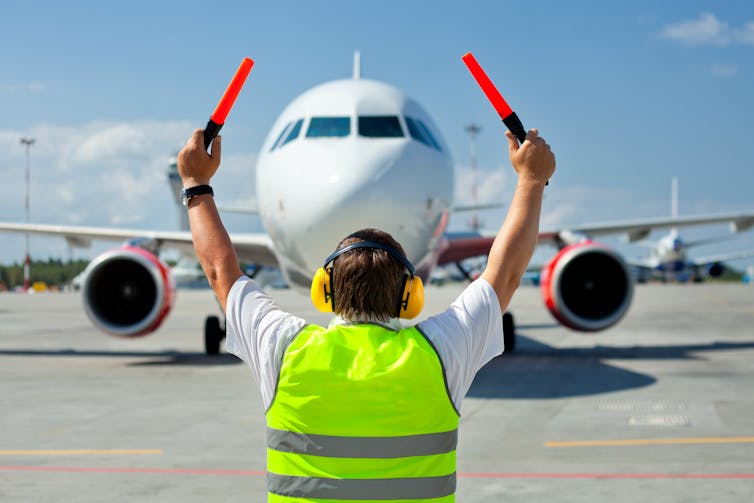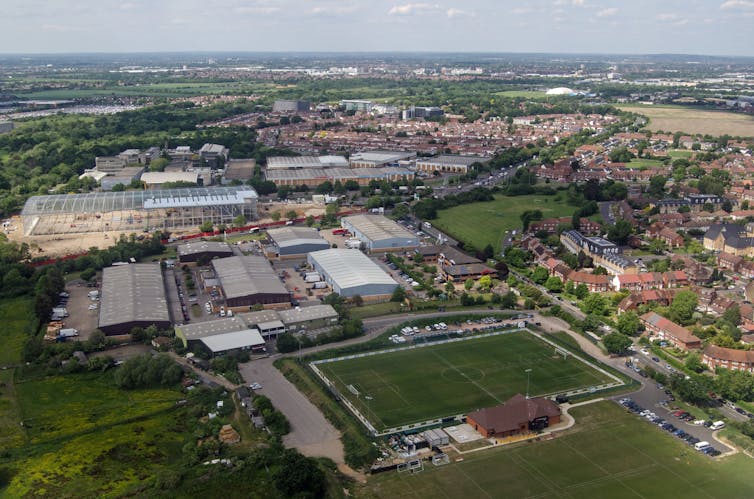
JetKat/Shutterstock
Tens of thousands of aircraft have been grounded for well over a year due to the pandemic. In April 2020 air travel around the world was cut by 94% from April 2019. By June 2021 it was still 60% down on June 2019 thanks to holidays being cancelled, work trips shelved, and long-planned journeys to see family and friends moved to another time.
Never has any global industry collapsed with such speed. In climate terms, this has been a cause for celebration. It has represented a chance for reducing emissions that contribute significantly to climate change and pollute our air.
Some people who live close to an airport may also have welcomed the drop in noise. But many others will be worrying about the effect the long-term reduction in air travel may have on their community’s economy.
Will the industry bounce back?
Industrial bodies estimate that it might take five years for passenger demand to return to pre-pandemic levels. That’s a longer expected recovery than any other mode of transport. Globally, an estimated 46 million jobs have been deemed at risk. This isn’t just pilots or cabin crew; it’s also those who screen your baggage or make your lunch.
But will the air industry even bounce back in five years? Research our team conducted in early 2021 in Bristol, an English city with an airport and a century-old aviation industry, found that close to 60% of those surveyed expect to fly less in the future. Many of our respondents gave climate change and the pandemic as equally important reasons. Other polling has shown that many elsewhere remain wary of flying in the future too.
Businesses may also operate differently. Polling has found that four in ten business travellers are likely to fly less in the future. Business-class seats are an important part of airline income – on some flights corporate travel can represent 75% of revenue.
Setting aside ideas about electric planes for now, it seems obvious that we will need to fly less to move to a zero-carbon economy. Two-thirds of people want a post-pandemic economic recovery to prioritise climate change. This means fewer planes, and fewer jobs for crew and baggage handlers and so on.
Rebuilding communities
The decline of older industries such as mining, textiles or pottery resulted in high unemployment in towns which were massively dependent on one of them. We are all familiar with how the closure of a local pit or car plant caused the decline of once vibrant towns, leaving a generation to struggle with unemployment and the need to retrain.
Steel mills were nestled deep in the fabric of nearby communities. Their closure removed the pivot around which lives, work and leisure were based. So with the pandemic, whole communities are at risk of a similar economic decline.
In summer 2020 the rate of those jobless (be it unemployed or on furlough) was higher in areas near UK airports. In Hounslow (near London Heathrow) this was 40% of the population – with an estimated £1 billion loss to the borough’s economy. At Gatwick airport in 2020, there were job losses for 40% of its workforce, many of whom live in nearby towns such as Crawley.
BasPhoto/Shutterstock
Many towns and communities are economically dependent on nearby airports. Luton Airport is estimated to have sustained over 27,000 jobs (directly and indirectly) and is a major employer in the region. The decline of the sector has broader effects on subsidiary industries too, such as taxis, maintenance, catering and hotels.
So what is to be done? The Green Jobs Taskforce, an industry and government initiative set up in 2020 to look at future employment, has called on the UK government to invest in jobs related to wind turbines, electric trains and replacing gas boilers.
Any version of a green new deal is necessarily a job-heavy economy, with a great deal of work needed to alter the infrastructure that powers our current lifestyle. The UK government’s Ten Point Plan for Green Industrial Revolution pledges 250,000 green jobs. The political question here is whether politicians and policymakers will be brave enough to resist a bounce back for aviation and invest in a longer term future for these airport towns, to avoid them suffering a decade of decline.
This is likely to see aviation jobs lost, and will require very targeted support for cities or regions reliant on airport employment. To build back better, a green recovery must seek to support these communities and provide them with new opportunities and livelihoods.![]()
——————————–
This blog was written by Cabot Institute for the Environment members Dr Ed Atkins, Lecturer, School of Geographical Sciences, University of Bristol and Professor Martin Parker, Professor of Organisation Studies, University of Bristol. This article is republished from The Conversation under a Creative Commons license. Read the original article.
 |
| Martin Parker |
 |
| Ed Atkins |

